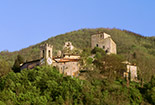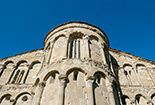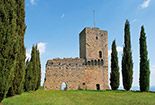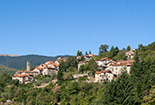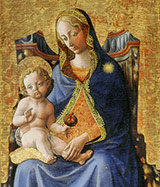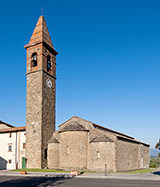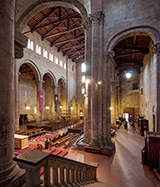Pieve di San Martino a Vado a Strada
in Casentino, a Tuscan valley with which you can get familiar in every detail through this site
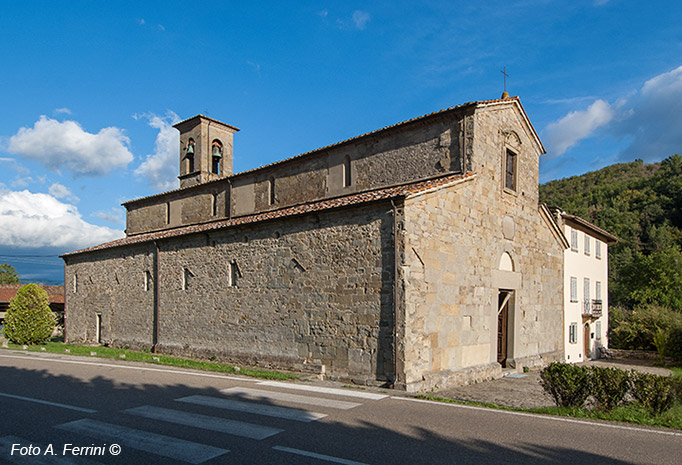
Texts and photos by Alessandro Ferrini ©
41 accurately described images of Pieve di Strada. Click to enlarge
The Parish Church of Strada, essence of the Romanesque
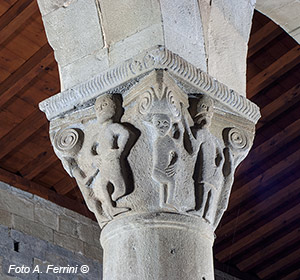 The Parish Church of Saint Martin of Vado of Strada in the Casentino is located at the beginning of the town of Strada for those who come from Poppi and Bibbiena. This church is one of the most important Romanesque parish churches of this Tuscan valley. Its capitals, which are placed on top of the twelve columns that separate the three naves, are characterized by a beauty and charm beyond words. They represent the great added value of this sacred building, which was built in its current dimensions and shape in the 12th century.
The Parish Church of Saint Martin of Vado of Strada in the Casentino is located at the beginning of the town of Strada for those who come from Poppi and Bibbiena. This church is one of the most important Romanesque parish churches of this Tuscan valley. Its capitals, which are placed on top of the twelve columns that separate the three naves, are characterized by a beauty and charm beyond words. They represent the great added value of this sacred building, which was built in its current dimensions and shape in the 12th century.
A document of 1028 mentions the existence of a previous building located in this exact place, it is a church dedicated to Saint Martin in Terdinula. Some architectural elements of this prior building are still present and clearly visible in 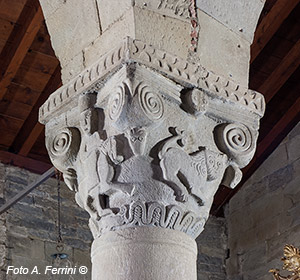 the current Romanesque parish church, which changed its name into Saint Martin of Vado due to the presence of a crossing over the Solano torrent (Vado comes from "guado", which means ford) near the church. As all the Medieval parish churches, it was built along an important "road system" that from the Casentino led both towards Florence and Fiesole and towards the Valdarno through the crossings of Vetrice, Gastra and Reggello located on the ridge of the Pratomagno.
the current Romanesque parish church, which changed its name into Saint Martin of Vado due to the presence of a crossing over the Solano torrent (Vado comes from "guado", which means ford) near the church. As all the Medieval parish churches, it was built along an important "road system" that from the Casentino led both towards Florence and Fiesole and towards the Valdarno through the crossings of Vetrice, Gastra and Reggello located on the ridge of the Pratomagno.
The Counts Guidi, who owned the above Castello di San Niccolò, paid for this parish church. The name of the vast municipal territory, where we also find this sacred building, comes from this castle. Building such an important church for the populace was a prestigious gesture for the noble landowners of this area and it gave them much eminence. In addition, it was useful from the administrative point of view: being the baptismal font only in the parish church, this was a sort of civil registry.
The Parish Church of Strada, together with the ones of Stia, Romena, Montemignaio and Socana, is part of the five most famous Romanesque parish churches of the Casentino. Among all of them, it is the one whose current appearance is the most similar to its original one of the 12th century in both dimensions and shape. This is not true for its bell tower, which originally was in the front part of the church, while nowadays it is in the back next to the apse. Over the centuries, the Parish Church of Saint Martin of Vado had undergone serious architectural revolutions, but the majority of them has been "nullify" by a great restoration work, which took place during the Sixties, supported by the Superintendency for Cultural Heritage of Arezzo.
The 17th and 18th century were the most spoiling for this church. After a flood caused by the overflowing of the near Solano torrent, the parish priest of that time decided to raise its floor of almost one meter in order to make the parish church safer against floods. As a result, the elegant column bases remained buried under the new pavement and the inside of the church became lower. The vaulted false ceilings erected underneath the truss increased the building's awkward look even more. Its walls were plastered and decorated with inappropriate friezes and festoons. Four altars were placed in each side nave. In order to let more light entering inside the church, the narrow openings on the central nave walls were replaced by much larger windows. The same happened to the small opening on the facade. Two more entryways were opened on the facade in line with the minor naves. The apsis was demolished in order to build a bigger one. As above mentioned, the bell tower located in the front part of the church along its right side was then moved back next to the new apse. Except for this last element and the square window on the facade, with the long and drastic restoration work above mentioned the church was revolutionised again, but in an "inverted sense" because it regained the sober and severe charm of its original Romanesque style. In fact, even the apsis was rebuilt on the foundations of the smaller previous one.
As the other important Romanesque churches in the Casentino, also the Parish Church of Saint Martin of Vado shows in its inside the three typical naves with trussed ceiling. However, the Parish Church of Strada is the only one still having the seven arches with their whole development laying 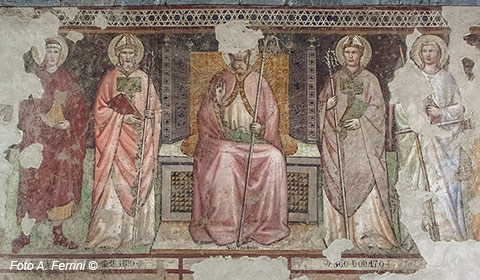 on six columns characterized by very beautiful capitals on top of them. These capitals present the same style of those ones in the Parish Churches of Romena and Stia; it is clear that they were made by either the same workers or workers coming from the same Lombard school. Nevertheless, as we can notice an evolution in terms of refinement from those ones of Romena to those of Stia, we can also notice an even further development for what regards refinement from those ones of Stia to those of Strada. Regardless of what they represent (plant elements, animals, human figures or others), we notice an incredible sculptural harmony in these capitals. The pages of this section will show these decorative elements located on top of the twelve columns, but they will also show other architectural peculiarities of this parish church, which could also be defined "art church" due to the presence of fine paintings. In particular: three frescoes taken from the Castle of Saint Niccolò's chapel and two paintings dating back to the 17th-18th century made by the Florentine artists Francesco Mati and Giovanni Antonio Pucci.
on six columns characterized by very beautiful capitals on top of them. These capitals present the same style of those ones in the Parish Churches of Romena and Stia; it is clear that they were made by either the same workers or workers coming from the same Lombard school. Nevertheless, as we can notice an evolution in terms of refinement from those ones of Romena to those of Stia, we can also notice an even further development for what regards refinement from those ones of Stia to those of Strada. Regardless of what they represent (plant elements, animals, human figures or others), we notice an incredible sculptural harmony in these capitals. The pages of this section will show these decorative elements located on top of the twelve columns, but they will also show other architectural peculiarities of this parish church, which could also be defined "art church" due to the presence of fine paintings. In particular: three frescoes taken from the Castle of Saint Niccolò's chapel and two paintings dating back to the 17th-18th century made by the Florentine artists Francesco Mati and Giovanni Antonio Pucci.



